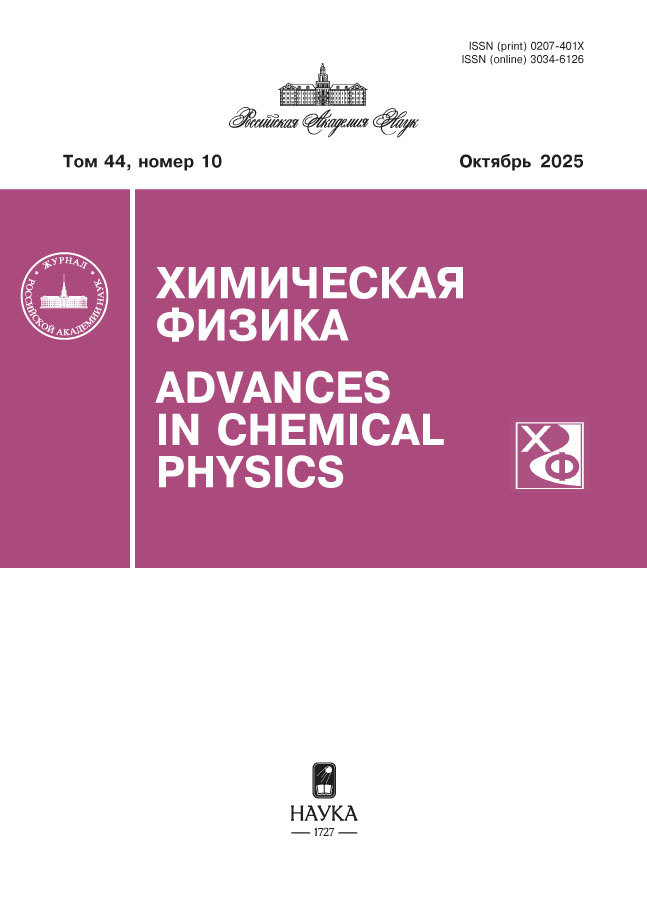Нековалентное взаимодействие атомов углерода, кремния и германия
- Авторы: Сокуров А.А.1, Рехвиашвили С.Ш.1
-
Учреждения:
- Институт прикладной математики и автоматизации – филиал Федерального государственного бюджетного научного учреждения “Федеральный научный центр “Кабардино-Балкарский научный центр Российской академии наук”
- Выпуск: Том 43, № 9 (2024)
- Страницы: 19-28
- Раздел: Строение химических соединений, квантовая химия, спектроскопия
- URL: https://cijournal.ru/0207-401X/article/view/680962
- DOI: https://doi.org/10.31857/S0207401X24090029
- ID: 680962
Цитировать
Полный текст
Аннотация
Из первых принципов (приближение электронного газа) проведен расчет потенциалов нековалентного взаимодействия для гомо- и гетороатомных пар углерода, кремния и германия без образования валентных химических связей. В расчетах учитывались кулоновский, кинетический, обменный и корреляционный вклады в энергию взаимодействия. Электронная плотность задавалась с учетом оболочечной структуры атомов в приближении Хартри–Фока. Для всех случаев вычислены параметры потенциалов Леннарда-Джонса и Морзе, а также константы дисперсионного взаимодействия. Показано, что для нековалентного взаимодействия известные эмпирические правила комбинирования Лоренца–Бертло для параметров потенциалов не всегда выполняются. На основе расчетов предложен новый обобщенный потенциал, который может использоваться в моделировании методами молекулярной динамики и Монте-Карло, а также при построении уравнений состояния. Проведены расчеты второго вириального коэффициента для пара одноатомного углерода.
Полный текст
Об авторах
А. А. Сокуров
Институт прикладной математики и автоматизации – филиал Федерального государственного бюджетного научного учреждения “Федеральный научный центр “Кабардино-Балкарский научный центр Российской академии наук”
Email: rsergo@mail.ru
Россия, Нальчик
С. Ш. Рехвиашвили
Институт прикладной математики и автоматизации – филиал Федерального государственного бюджетного научного учреждения “Федеральный научный центр “Кабардино-Балкарский научный центр Российской академии наук”
Автор, ответственный за переписку.
Email: rsergo@mail.ru
Россия, Нальчик
Список литературы
- Бараш Ю.С. Силы Ван-Дер-Ваальса. М.: Наука, 1988.
- Матиенко Л.И., Миль Е.М., Бинюков В.И. // Хим. физика. 2020. Т. 39. № 6. С. 87; https://doi.org/10.31857/S0207401X20060084
- Rapaport D.C. The Art of Molecular Dynamics Simulation. N.Y.: Cambridge University Press, 2004.
- Поттер Д. Вычислительные методы в физике. М.: Мир, 1975.
- Рит М. Наноконструирование в науке и технике. Введение в мир нанорасчета. Ижевск: РХД, 2005.
- Суздалев И.П. Нанотехнология: физико-химия нанокластеров, наноструктур и наноматериалов. М.: КомКнига, 2006.
- Гусев А.И. Наноматериалы, наноструктуры, нанотехнологии. М.: Физматлит, 2007.
- Kadau K., Barber J.L., Germann T.C. et al. // Philos. Trans. R. Soc., A. 2010. V. 368. P. 1547; https://doi.org/10.1098/rsta.2009.0218
- Cosden I.A., Lukes J.R. // Comput. Phys. Commun. 2013. V. 184. № 8. P. 1958; https://doi.org/10.1016/j.cpc.2013.03.009
- Гудман Ф., Вахман Г. Динамика рассеяния газа поверхностью. М.: Мир, 1980.
- Каплан И.Г. Межмолекулярные взаимодействия. Физическая интерпретация, компьютерные расчеты и модельные потенциалы. М.: Бином. Лаборатория знаний, 2017.
- Parr R.G., Yang W. Density-functional theory of atoms and molecules. Oxford University Press, 1989.
- Balamane H., Halicioglu T., Tiller W.A. // Phys. Rev. B. 1992. V. 46. № 4. P.2250; https://doi.org/10.1103/PhysRevB.46.2250
- Erhart P., Albe K. // Phys. Rev. B. 2005. V. 71. P. 035211; https://doi.org/10.1103/PhysRevB.71.035211
- Kim E.H., Shin Y.H., Lee B.J. // Calphad. 2008. V. 32. № 1. P. 34; https://doi.org/10.1016/j.calphad.2007.12.003
- Chu X., Dalgarno A. // J. Chem. Phys. 2004. V.121. № 9. P. 4083; https://doi.org/10.1063/1.1779576
- Zhang G.X., Tkatchenko A., Paier J. et al. // Phys. Rev. Lett. 2011. V. 107. P. 245501; https://doi.org/10.1103/PhysRevLett.107.245501
- Gordon R.G., Kim Y.S. // J. Chem. Phys. 1972. V. 56. № 6. P. 3122; https://doi.org/10.1063/1.1677649
- Waldman M., Gordon R.G. //Ibid 1972. V. 71. № 3. P. 1325; https://doi. org/10.1063/1.438433
- Дедков Г.В. // УФН 1995. Т. 165. № 8. С. 919; https://doi.org/10.3367/UFNr.0165.199508c.0919
- Strand T.G., Bonham R.A. // J. Chem. Phys. 1964. V. 40. № 6. P. 1686; https://doi.org/10.1063/1.1725380
- Abramowitz M., Stegun I.A. Handbook of mathematical functions with formulas, graphs, and mathematical tables. N. Y.: Dover Publications, 1972.
- Barker J.A., Pompe A. // Aust. J. Chem. 1967. V. 21 №7. P.1683; https://doi.org/10.1071/CH9681683
- Tang K. T., Toennies J. P. // J. Chem. Phys. 2003. V. 118. P.4976; https://doi.org/10.1063/1.1543944
- Магомедов М.Н. // ФТТ 2020. Т. 62. № 7. С. 998; https://doi.org/10.21883/FTT.2020.07.49462.026
- Шарафутдинов Г.З. // Вестн. МГУ. Сер. 1, Математика, Механика. 2017. № 6. С. 34; https://doi.org/10.3103/S0027133017060012
- Рехвиашвили С.Ш., Бухурова М.М., Сокуров А.А. // ЖНХ. 2020. T. 65. № 9. С. 1229; https://doi.org/10.31857/S0044457X20090135
- Рехвиашвили С.Ш. // Мат. моделирование. 2003. Т. 15. № 2. С. 62.
- Дохликова Н.В., Гатин А.К., Сарвадий С.Ю. и др. // Хим. физика. 2021. Т. 40. № 7. С. 67; https://doi.org/10.31857/S0207401X21070025
- Дохликова Н.В., Гатин А.К., Сарвадий С.Ю. и др. // Хим. физика. 2022. Т. 41. № 4. С. 72; https://doi.org/10.31857/S0207401X22040021
- Дохликова Н.В., Озерин С.А., Доронин С.В. и др. // Хим. физика. 2022. Т. 41. № 6. С. 72; https://doi.org/10.31857/S0207401X22060024
- Дохликова Н.В., Гатин А.К., Сарвадий С.Ю. и др. // Хим. физика. 2022. Т. 41. № 7. С. 76; https://doi.org/10.31857/S0207401X22070044
- Руденко Е.И., Дохликова Н.В., Гатин А.К. и др. // Хим. физика. 2023. Т. 42. № 7. С. 70; https://doi.org/10.31857/S0207401X23070166
- Pyykkö P., Atsumi M. // Chem. Eur. J. 2009. V. 15. P. 186; https://doi.org/10.1002/chem.200800987
- Мейсон Э., Сперлинг Т. Вириальное уравнение состояния. М.: Мир, 1972.
- Edalat M., Lan S.S., Pang F., Mansoori G.A. // Intern. J. Thermophys. 1980. V. 1. № 2. P. 177; https://doi.org/10.1007/BF00504519
- Nitzke I., Pohl S., Thol M., Span R., Vrabec J. // Mol. Phys. 2022. V. 120. № 11. P. 1; https://doi.org/10.1080/00268976.2022.2078240
Дополнительные файлы
















